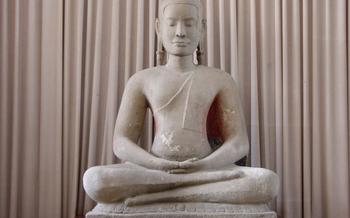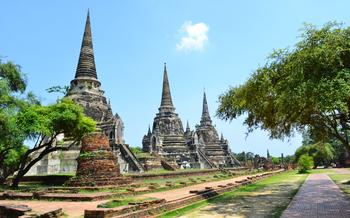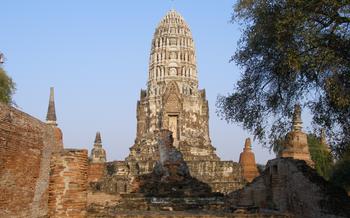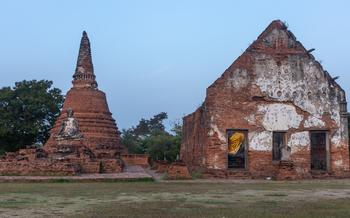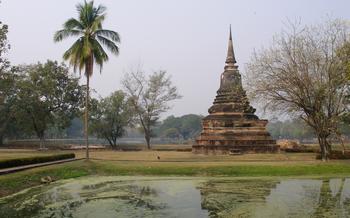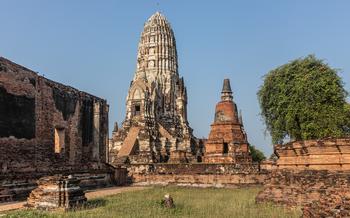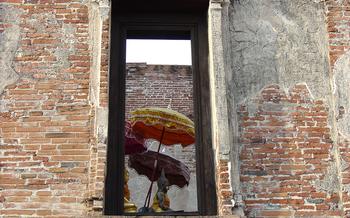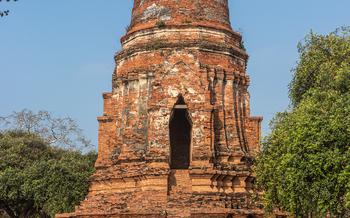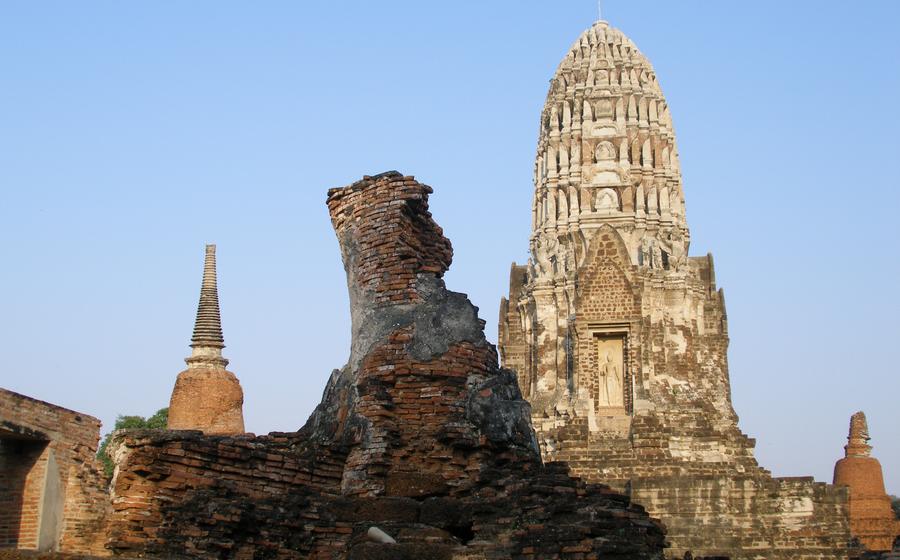
Wat Naphrameru Rajikaram
- Brief history of the temple's construction and significance
- Exploring the Temple Grounds
- The Ordination Hall: A Majestic Structure
- The Phra Prang: A Royal Monument
- The Buddha Images: Serenity and Beauty
- The Royal Palace: A Glimpse into the Past
- The Elephant Corral: A Unique Attraction
- The Ayothaya Historical Park: A UNESCO World Heritage Site
- Festivals and Events: Celebrating Thai Culture
- Local Cuisine: Delights of Ayutthaya
- Insider Tip: Hidden Gems and Photography Spots
Brief history of the temple's construction and significance
In the heart of Thailand's ancient capital, Ayutthaya, stands a temple of exquisite beauty and historical significance - Wat Naphrameru Rajikaram. Constructed in the early 17th century during the reign of King Prasat Thong, this sacred site served as the royal temple of the Ayutthaya Kingdom. Its name, meaning "the temple of the royal crematorium," reflects its original purpose as a place where the ashes of deceased royal family members were enshrined. Over the centuries, Wat Naphrameru Rajikaram has undergone renovations and expansions, transforming it into the awe-inspiring architectural marvel it is today, a testament to the grandeur and splendor of the Ayutthaya era.
Exploring the Temple Grounds
As you step into the temple complex, you'll be greeted by a serene and sacred atmosphere that invites contemplation and exploration. At the heart of Wat Naphrameru Rajikaram lies the awe-inspiring Ordination Hall, a masterpiece of Ayutthayan architecture. Its towering spires and intricate carvings are a testament to the craftsmanship and devotion of the ancient builders.
Take your time to wander through the spacious grounds, discovering hidden corners and lesser-known spots that offer unique perspectives and opportunities for photography. Admire the intricate murals that adorn the walls of the temple buildings, depicting scenes from Buddhist mythology and Thai history. These vibrant and well-preserved artworks provide a glimpse into the beliefs and traditions of the past.
Don't miss the Phra Prang, a majestic stupa that stands tall in the center of the complex. Its elegant bell-shaped design is a symbol of royal power and authority. As you climb the steep stairs to the top, you'll be rewarded with panoramic views of the surrounding countryside, making it the perfect spot to capture stunning photographs.
The Ordination Hall: A Majestic Structure
The ordination hall, known as Phra Ubosot, is the most significant building within Wat Naphrameru Rajikaram. It stands as a testament to the architectural prowess and religious devotion of the Ayutthaya Kingdom. Constructed in the 17th century, the ordination hall served as a sacred space for monks to undergo ordination ceremonies, a rite of passage that marks their entry into the Buddhist order.
The ordination hall is a masterpiece of Ayutthayan architecture, showcasing intricate details and elegant design elements. Its towering spire, adorned with delicate stucco work, reaches towards the heavens, symbolizing the spiritual aspirations of the monks within. The exterior walls are adorned with intricate carvings depicting scenes from the life of Buddha, each panel narrating a story of compassion, wisdom, and enlightenment.
Inside the ordination hall, visitors are greeted by a serene and awe-inspiring atmosphere. The spacious interior is dominated by a large Buddha image, seated serenely on a lotus pedestal. The walls are adorned with vibrant murals depicting Jataka tales, stories of Buddha's previous lives, each brushstroke imbued with spiritual teachings and moral lessons. The air is filled with the gentle chanting of monks, their voices harmonizing in a melodious chorus that echoes through the hall, creating a sense of tranquility and devotion.
The Phra Prang: A Royal Monument
Majestic Symbol of Power and Divinity
The Phra Prang, or "sacred tower," is one of the most iconic structures within the temple grounds, standing tall and proud as a symbol of royal power and divinity. Built in the 15th century, this towering monument served as the central sanctuary of the royal palace during the Ayutthaya Kingdom. Its architectural design is a masterpiece of Khmer influence, characterized by a series of concentric terraces and a distinctive spire that reaches towards the heavens.
The Phra Prang's religious significance is intertwined with the history of the Ayutthaya Kingdom. It was believed to house the sacred relics of the Buddha, making it a revered site for pilgrims and worshippers. According to legend, the relics were brought to Ayutthaya from Sri Lanka by King Naresuan, who placed them within the Phra Prang to ensure the kingdom's prosperity and protection.
Over the centuries, the Phra Prang has weathered the storms of time and war, undergoing several restorations and renovations. Despite these changes, it retains its original grandeur and majesty, serving as a testament to the skill and artistry of the ancient Khmer builders. Today, the Phra Prang stands as a symbol of Ayutthaya's rich history and cultural heritage, attracting visitors from around the world who come to marvel at its architectural splendor and spiritual significance.
The Buddha Images: Serenity and Beauty
Wat Naphrameru Rajikaram is home to a diverse collection of Buddha images, each exuding a sense of serenity and beauty. These statues, crafted with intricate detail and precision, represent different styles and periods of Thai art.
Among the most notable is the Phra Buddha Sihing, a 13th-century bronze statue that is considered one of the most sacred images in Thailand. The Buddha is depicted in a seated position, with a serene expression and an aura of divinity. The statue's intricate detailing, from the finely carved robes to the delicate facial features, is a testament to the skill of the artisans who created it.
Another highlight is the Phra Buddha Chinnarat, a 15th-century bronze statue that is revered for its exceptional beauty. The Buddha is depicted in a standing position, with a graceful posture and a gentle smile. The statue's harmonious proportions and elegant lines have earned it a reputation as one of the finest examples of Thai Buddhist art.
In addition to these iconic statues, Wat Naphrameru Rajikaram also houses numerous smaller Buddha images, each with its unique characteristics. Some are carved from wood, others from stone or metal, and each conveys a different aspect of the Buddha's teachings.
Of particular interest is the Emerald Buddha replica, a smaller version of the famous Emerald Buddha that is enshrined in the Grand Palace in Bangkok. This replica is crafted from green glass and is believed to have been created in the 19th century. It is a popular object of devotion for visitors to the temple, who come to pay their respects and seek blessings.
Whether you are a devout Buddhist or simply an admirer of art and history, the Buddha images at Wat Naphrameru Rajikaram are sure to leave a lasting impression.
The Royal Palace: A Glimpse into the Past
The Royal Palace within the temple complex of Wat Naphrameru Rajikaram serves as a historical testament to the grandeur and opulence of the Ayutthaya Kingdom. Though partially ruined, its surviving structures and architectural remnants offer a glimpse into the lavish lifestyle and regal grandeur of the past.
The palace was once the residence of King Naresuan the Great, one of the most revered and celebrated monarchs of the Ayutthaya era. It was here that he conducted royal ceremonies, received foreign dignitaries, and made important decisions that shaped the destiny of the kingdom.
Although much of the palace has been lost to the ravages of time and warfare, the surviving structures still exude an aura of grandeur. The audience hall, with its intricate carvings and soaring pillars, hints at the opulence and majesty of the royal court. The throne room, though devoid of its original furnishings, still evokes a sense of awe and reverence.
Wandering through the ruins of the Royal Palace, one can't help but be transported back in time, imagining the bustling court, the royal processions, and the grandeur that once filled these halls. It's a poignant reminder of the transient nature of power and the enduring legacy of history.
The Elephant Corral: A Unique Attraction
Nestled within the majestic grounds of Wat Naphrameru Rajikaram lies a unique and captivating attraction: the elephant corral. This historical site once served as a royal stable, housing the magnificent elephants that played a crucial role in Ayutthaya's grand processions and military campaigns. Today, the elephant corral stands as a testament to Thailand's rich cultural heritage and offers visitors a glimpse into the kingdom's deep-rooted connection with these gentle giants.
Visitors to the elephant corral can witness firsthand the grace and intelligence of these majestic creatures. Daily elephant shows and performances showcase the elephants' remarkable abilities, from intricate tricks and stunts to painting and playing musical instruments. These captivating displays not only entertain but also educate, providing insights into the unique bond between humans and elephants.
For those seeking a more immersive experience, the elephant corral offers the opportunity to interact with the elephants up close. Visitors can feed and bathe these gentle giants, creating lasting memories and gaining a deeper appreciation for the beauty and intelligence of these magnificent animals. Elephant rides are also available, allowing visitors to embark on a leisurely journey through the temple grounds, surrounded by the lush tropical landscape.
The Ayothaya Historical Park: A UNESCO World Heritage Site
Wat N Historical Park**, a UNESCO World Heritage Site that encompasses the ruins of the ancient city of Ayutthaya. This vast park is home to a treasure trove of historical and archaeological wonders, including numerous temples, palaces, and other structures that showcase the grandeur of the Ayutthaya Kingdom.
Exploring the park:
-
Wat Mahathat: Explore the picturesque ruins of Wat Mahathat, where a centuries-old Buddha head entwined by tree roots is a poignant symbol of the kingdom's resilience.
-
Wat Phra Ram: Admire the intricate carvings and murals of Wat Phra Ram, which was once the royal temple of King Ramathibodi I, the founder of the Ayutthaya Kingdom.
-
Wat Chaiwatthanaram: Marvel at the grandeur of Wat Chaiwatthanaram, a stunning temple complex known for its towering prang and intricate stucco decorations.
-
Elephant Kraal: Step back in time at the Elephant Kraal, where elephants were once corralled for royal ceremonies and battles.
Planning your visit:
-
Allow plenty of time: Set aside at least a full day to explore the park's many highlights, as the sheer size and number of sites can be overwhelming.
-
Choose a bike or tuk-tuk: To cover the vast distances within the park, consider renting a bicycle or hiring a tuk-tuk driver to navigate the grounds efficiently.
-
Wear comfortable shoes: Be prepared for a lot of walking on uneven surfaces, so wear comfortable shoes to avoid discomfort.
-
Visit during the cooler months: The best time to visit the park is during the cooler months (November to February) to avoid the sweltering heat.
-
Bring a camera: Don't forget your camera to capture the stunning architecture, serene landscapes, and vibrant local life.
Festivals and Events: Celebrating Thai Culture
Wat Naphrameru Rajikaram comes alive during various festivals and events that showcase the vibrant culture and traditions of Thailand. The most notable celebration is the annual Ayutthaya Historical Park Fair, which takes place over several days in November or December. During this festival, the temple grounds transform into a lively marketplace filled with food stalls, cultural performances, and traditional Thai games. Visitors can experience traditional Thai music and dance, watch skilled artisans demonstrate their crafts, and indulge in a variety of local delicacies.
Another significant event is the Kathin Ceremony, which takes place in October or November. During this ceremony, Buddhists offer new robes to monks as a symbol of respect and gratitude. It is a colorful and solemn event that offers a glimpse into Thai religious traditions.
For those interested in experiencing Thai culture in a unique way, the temple also hosts regular meditation retreats and workshops. These retreats provide an opportunity to learn about Buddhist teachings, practice meditation, and immerse oneself in the tranquility of the temple grounds.
Local Cuisine: Delights of Ayutthaya
Ayutthaya's culinary scene is a harmonious blend of traditional Thai flavors and unique local specialties. Visitors can indulge in a range of delectable dishes that showcase the region's rich history and cultural influences.
A must-try dish is Khao Soi Ayutthaya, a flavorful noodle soup made with coconut milk, curry paste, and tender chicken or beef. The broth is rich and fragrant, with a perfect balance of spicy and creamy.
Another popular dish is Pad See Ew, a stir-fried noodle dish with a sweet and savory sauce. The noodles are stir-fried with vegetables, meat, and a delicious sauce made from soy sauce, oyster sauce, and sugar.
For a taste of local street food, try Roti Sai Mai, a crispy pancake filled with sweet or savory fillings. The most popular fillings include bananas, chocolate, and condensed milk.
Ayutthaya is also known for its delicious desserts, such as Khanom Chan, a steamed coconut cake with a sweet and chewy texture. Another popular dessert is Lod Chong, a shaved ice dessert with green rice noodles, coconut milk, and sweet syrup.
When in Ayutthaya, be sure to visit the Ayutthaya Floating Market. This vibrant market is a great place to sample a variety of Thai dishes and delicacies, from fresh seafood to traditional sweets.
For a truly authentic culinary experience, try one of the many local restaurants near Wat Naphrameru Rajikaram. These restaurants offer a wide range of Thai dishes, from classic favorites to regional specialties.
Whether you're looking for a quick snack or a leisurely meal, Ayutthaya has something to offer every foodie. So come hungry and prepare to indulge in the delights of Ayutthaya's culinary scene.
Insider Tip: Hidden Gems and Photography Spots
To fully experience the beauty of Wat Naphrameru Rajikaram, venture beyond the main tourist areas and explore its hidden corners. Discover the serene lotus pond, where you can capture stunning reflections of the temple's spires. Seek out the ancient Bodhi tree, believed to be over 300 years old, and immerse yourself in its tranquil aura.
For photography enthusiasts, the temple grounds offer a treasure trove of opportunities. The intricate carvings on the ordination hall's doors provide a captivating subject, while the delicate murals inside the viharn reveal their secrets when viewed up close. Don't miss the chance to capture the Phra Prang's majestic silhouette against the golden hues of sunset, a truly breathtaking sight.
To make the most of your visit, plan your trip around the temple's daily routine. Arrive early in the morning to witness the monks' alms-giving ceremony, a sacred ritual that offers a glimpse into the spiritual life of the temple. Alternatively, visit during the late afternoon, when the setting sun casts a warm glow on the temple's ancient structures, creating a magical atmosphere.
